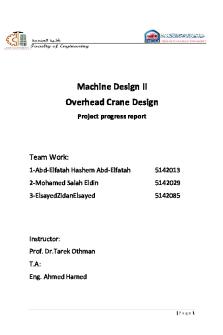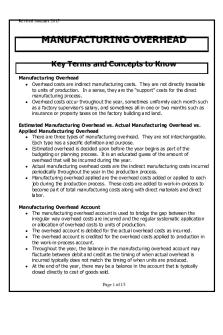Overhead Analysis PDF

| Title | Overhead Analysis |
|---|---|
| Course | Accounting |
| Institution | City of Glasgow College |
| Pages | 6 |
| File Size | 141.7 KB |
| File Type | |
| Total Downloads | 49 |
| Total Views | 164 |
Summary
Download Overhead Analysis PDF
Description
Cost Accounting – Overhead Analysis
Types of cost There are 3 categories of costs a business must consider Materials Labour Overheads
Covering all costs Only production departments produce goods for resale. All costs, direct and indirect, must be allotted to them. This ensures that selling price of each unit is set high enough to cover the total costs and make a profit.
Cost Centres Departments are often called Cost Centres. A cost centre is part of the business to which costs can be charged.
Production Cost Centre A cost centre where work is done on the products. Examples are milling, grinding, finishing, assembly and polishing.
Service Cost Centre Areas such as canteen, personnel, maintenance and administration. Give service to the other cost centres but are not directly concerned with producing the product. Costs allocated to service cost centres are eventually charged to a production cost centre Ensures all costs are absorbed into the cost of making each product.
Charging Overheads to Cost Centres:
Allocation An overhead is directly charged to a cost centre. The overhead is wholly the responsibility of that one cost centre. Eg stationary can be allocated wholly to the administration cost centre. Doesn’t happen this easily very often!!!
Apportionment Divide an overhead between a number of cost centres. When allocation is not possible. The overhead has been used by more than one cost centre. Eg rent is paid for the entire factory and will need to be divided between all the cost centres in the factory.
Apportionment: The most common methods of apportionment are listed:
Overhead Cost 1. rent, rates, heating and lighting 2. canteen and factory admin costs 3. depreciation and insurance of plant and machinery 4. power
Basis of Apportionment 1. floor area size of the department 2. Number of employees 3. book value of the fixed assets 4. horse power of the machines or kilo watt hours
Apportionment by floor area The total overhead is divided between the cost centres in proportion to the area they each occupy.
This method is suitable to apportion rent, rates, building repairs, property insurance and lighting and heating.
Apportionment of Rent Total floor area of the business = 200 m² Floor area of the assembly department = 50 m² Total rent of the business = £12,000 The amount of rent to be apportioned to the assembly department would be 50/200 x £12,000 = £3,000.
Apportionment by number of employees the total overhead is divided between the cost centres in proportion to the number of employees working in each cost centre. This method is suitable to apportion supervision, wages, canteen costs and administration.
Apportionment of Administration Overhead Total number of employees of the business = 150 Number of employees in the assembly department = 30 Total cost of administration = £18,000 The amount of administration to be apportioned to the assembly department would be 30/150 x £18,000 = £3,600.
Apportionment by book value of fixed assets The total overhead is divided between cost centres in proportion to the value of its fixed assets. This method is suitable to apportion depreciation and insurance of plant and machinery.
Apportionment of Depreciation Overhead Book Value of Fixed Assets in the business = £500,000 Book Value of Fixed Assets in the assembly department = £150,000
Total cost of Depreciation = £50,000 The amount of depreciation to be apportioned to the assembly department would be 150,000/500,000 x £50,000 = £15,000.
Apportionment by kilo watt hours Power is the electricity used to drive machinery and the amount used by each cost centre is normally expressed in kwhrs. This method is suitable to apportion power, water and gas - NOT HEAT AND LIGHT
Apportionment of Power Overhead Total power used by the business = 10,000 kw hours Number of kw hours used in the assembly department = 6,500 kw hours Total cost of power = £5,000 The amount of power to be apportioned to the assembly department would be 6,500/10,000 x £5,000 = £3,250.
Other methods of apportionment: Other methods include: By number of labour hours By number of machine hours By cubic capacity (how much space does the cost centre take up). The method of calculation is the same.
Service Cost Centres to Production Cost Centres All service overheads must be charged to production costs centres. Ensures that all overheads are included when calculating the total cost of a product. Reapportion service costs centres to production cost centres.
Absorption of Overheads Apportion overhead costs to the production departments. Absorb the overhead cost into the cost of the each unit produced.
Allows each unit produced to carry a fair share of the overhead cost. The total cost per unit will be realistic and a suitable selling price can be fixed. The rate calculated for applying the overhead to the cost unit is called the overhead absorption rate. If the units produced are identical, the total overhead cost could simply be divided by the number of units produced = rate per unit produced. Rate per Unit Produced Example:
Total budgeted overheads
= £60,000
No. of units produced = 20,000
Absorption rate per unit
= £3 per unit
If the units produced vary and the productive process is labour intensive, it might be considered fairer to use the time spent working on the various units (labour hours) as the basis for apportioning costs = rate per direct labour hour. Rate per Direct Labour Hour Example:
Total budgeted overheads
= £60,000
Total labour hours worked
= 15,000
Absorption rate per direct labour hour = £4 per direct labour hour Where manufacture involves a significant amount of machining, the hours of machine time might be an appropriate basis = rate per machine hour. Rate per Machine Hour Example:
Total budgeted overheads
= £60,000
Total machine hours worked = 20,000
Absorption rate per machine hour = £3 per machine hour
Budgeted vs Actual Overheads Budgeted (estimated) overhead costs are used. The business doesn’t know the actual cost of the overhead until the end of the period. Based on past figures (allowing for increases/decreases in production and prices). Over and Under Absorption
At the end of the year, it is necessary to compare the overheads absorbed to the actual overheads. If the amount absorbed is greater than the actual amount; We have OVER ABSORBED. If the amount absorbed is less than the actual amount; We have UNDER ABSORBED If we have OVER ABSORBED. Record the excess as income If we have UNDER ABSORBED Record the shortfall as an expense...
Similar Free PDFs

Overhead Analysis
- 6 Pages

Flexible Budgets and Overhead Analysis
- 120 Pages

Factory Overhead Cost Variance
- 2 Pages
![Biaya Overhead Pabrik [BOP]](https://pdfedu.com/img/crop/172x258/zdg64ml1pw74.jpg)
Biaya Overhead Pabrik [BOP]
- 17 Pages

FOH - factory overhead
- 9 Pages

Overhead Crane Design
- 50 Pages

SAP - Overhead Cost Orders
- 199 Pages

Ch08 Overhead Costs Variances
- 43 Pages

2b. Manufacturing Overhead CR
- 15 Pages

Resume Biaya Overhead Pabrik
- 8 Pages
Popular Institutions
- Tinajero National High School - Annex
- Politeknik Caltex Riau
- Yokohama City University
- SGT University
- University of Al-Qadisiyah
- Divine Word College of Vigan
- Techniek College Rotterdam
- Universidade de Santiago
- Universiti Teknologi MARA Cawangan Johor Kampus Pasir Gudang
- Poltekkes Kemenkes Yogyakarta
- Baguio City National High School
- Colegio san marcos
- preparatoria uno
- Centro de Bachillerato Tecnológico Industrial y de Servicios No. 107
- Dalian Maritime University
- Quang Trung Secondary School
- Colegio Tecnológico en Informática
- Corporación Regional de Educación Superior
- Grupo CEDVA
- Dar Al Uloom University
- Centro de Estudios Preuniversitarios de la Universidad Nacional de Ingeniería
- 上智大学
- Aakash International School, Nuna Majara
- San Felipe Neri Catholic School
- Kang Chiao International School - New Taipei City
- Misamis Occidental National High School
- Institución Educativa Escuela Normal Juan Ladrilleros
- Kolehiyo ng Pantukan
- Batanes State College
- Instituto Continental
- Sekolah Menengah Kejuruan Kesehatan Kaltara (Tarakan)
- Colegio de La Inmaculada Concepcion - Cebu





